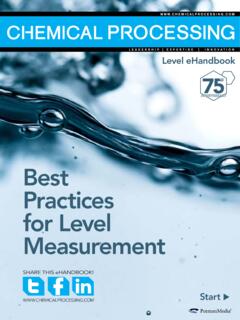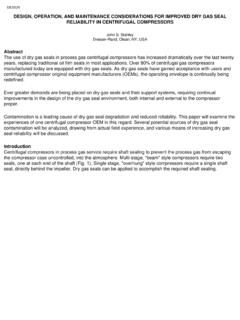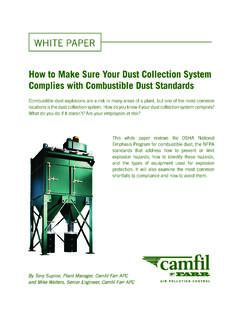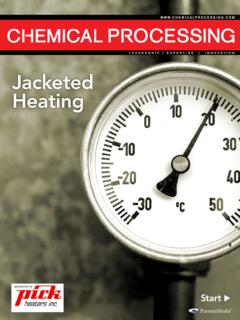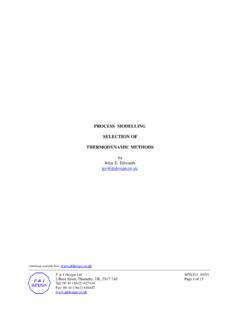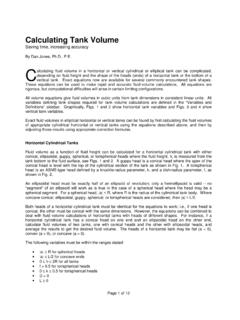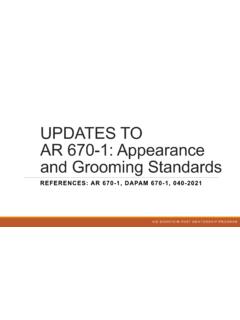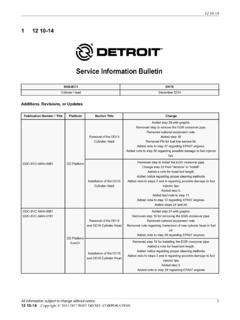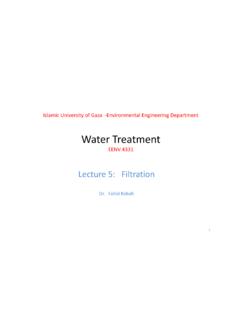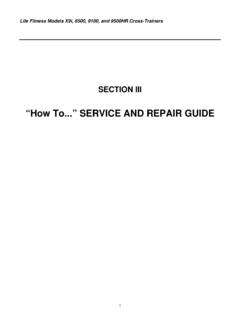Transcription of Calculating Tank Wetted Area - Chemical Processing
1 Page 1 of 17 Calculating Tank Wetted Area Saving time, increasing accuracy By Dan Jones, , alculating Wetted area in a partially-filled horizontal or vertical cylindrical or elliptical tank can be complicated, depending on fluid height and the shape of the heads (ends) of a horizontal tank or the head (bottom) of a vertical tank. Exact equations are now available for several commonly-encountered tank shapes. These equations can be used to make rapid and accurate Wetted -area calculations. All equations are rigorous. All area equations give Wetted areas in square units from tank dimensions in consistent linear units. All variables defining tank shapes required for tank Wetted -area calculations are defined in the Variables and Definitions sidebar.
2 Graphically, Figs. 1 and 2 show horizontal cylindrical tank parameters, Figs. 3 and 4 show vertical cylindrical tank parameters, and Fig. 5 shows some horizontal elliptical tank parameters . Elliptical horizontal tanks with hemiellipsoidal heads and vertical tanks with hemiellipsoidal bottoms are the only types of elliptical tanks considered. Horizontal Cylindrical Tanks Wetted area as a function of fluid height can be calculated for a horizontal cylindrical tank with either conical, hemispheroidal, guppy, spherical , or torispherical heads where the fluid height, h, is measured from the tank bottom to the fluid surface, see Figs. 1 and 2. A guppy head is a conical head of a horizontal tank where the apex of the conical head is level with the top of the cylindrical section of the tank as shown in Fig.
3 1. A torispherical head is an ASME-type (dished) head defined by a knuckle-radius parameter, k, and a dish-radius parameter, f, as shown in Fig. 2. A spheroidal head must be a hemispheroid; only a hemispheroid is valid no segment of an spheroid will work as it will in the case of a spherical head where the head may be a spherical segment. For a spherical head, |a| R, where R is the radius of the cylindrical tank body. Where concave conical, hemispheroidal, guppy, spherical , or torispherical heads are considered, then |a| L/2. Both heads of a horizontal cylindrical tank must be identical for the equations to work; , if one head is conical, the other must be conical with the same dimensions. However, the equations can be combined to deal with Wetted -area calculations of horizontal tanks with heads of different shapes.
4 For instance, if a horizontal cylindrical tank has a conical head on one end and a spherical head on the other end, calculate fluid Wetted areas of two tanks, one with conical heads and the other with spherical heads , and average the results to get the desired Wetted area. The heads of a horizontal tank may be flat (a = 0), convex (a > 0), or concave (a < 0). Wetted head areas are the same for convex or concave heads with the same dimensions, so the same formulas can be used for either convex or concave heads . The following variables must be within the ranges stated: |a| R for spherical heads |a| L/2 for concave ends 0 h 2R for all tanks f > for torispherical heads 0 < k < for torispherical heads D > 0 L 0 C Page 2 of 17 Variables and Definitions Sidebar (See Figs.)
5 1-5) a is the distance a horizontal tank's heads extend beyond (a > 0) or into (a < 0) its cylindrical or elliptical body section or the depth the bottom extends below the cylindrical or elliptical body section of a vertical tank. For a horizontal tank with flat heads or a vertical tank with a flat bottom a = 0. b is the horizontal semiaxis of the elliptical cross section of a horizontal elliptical tank or the major semiaxis of the elliptical cross section of a vertical elliptical tank. c is the vertical semiaxis of the elliptical cross section of a horizontal elliptical tank or the minor semiaxis of the elliptical cross section of a vertical elliptical tank. C is the Wetted cross-sectional length of the fluid in a horizontal tank's cylindrical section. D is the diameter of the cylindrical section of a horizontal or vertical tank.
6 F is the dish-radius parameter for tanks with torispherical (dished) heads (ends or bottoms); fD is the dish radius. h is the height of fluid in a tank measured from the lowest part of the tank to the fluid surface. k is the knuckle-radius parameter for tanks with torispherical heads (ends or bottoms); kD is the knuckle radius. L is the length of the cylindrical section of a horizontal tank. r is the radius of a spherical head of a horizontal tank or a spherical bottom of a vertical tank. R is the radius of the cylindrical section of a horizontal or vertical tank. S is the Wetted area, of fluid depth h, in a horizontal or vertical cylindrical tank. Page 3 of 17 Horizontal Cylindrical Tank Equations Here are the specific equations for Wetted surface areas of horizontal cylindrical tanks with conical, hemispheroidal, guppy, spherical , and torispherical heads (use radian angular measure for all trigonometric functions, and D/2 = R > 0 for all equations): Conical heads .
7 ----++=-2122222hRh)hR(RhRcosRRRaCLS .. Dhaall0 Hemispheroidal heads . ()() ---+--+-+=RhRRRRaRaRRCLS22022242222224xd ydxyxyx .. Dhaall0 special cases of hemispheroidal heads : 212222hRh)hR(RhRcosRCLS----+=- .. =Dha00 22222222aRRaRRlnaR2 RaRLRS---+-p+p+p= .. =<<RhRa0 ()DLRS+p= .. ==RhRa aRcosRaRaRLRS12222--p+p+p= .. =>RhRa 22222222aRRaRRlnaRRaR2LR2S---+-p+p+p= .. =<<DhRa0 ()DLR2S+p= .. ==DhRa aRcosRaRaRLRS12222222--p+p+p= .. =>DhRa Page 4 of 17 Guppy heads . --- -+ --++=RhRR)R(RaRRaCLS2202221214xdydxxyxy .. Dhaall0 spherical heads .. <DhRa00 special cases for spherical heads : 212222hRh)hR(RhRcosRCLS----+=.
8 =Dha00 Rh2 CLSp+= .. |a|=R ()22 RaCLS+p+= .. h=R ()22Ra2 CLS+p+= .. h=D ()() ---+- ++=RhRxaRaRasinaRaCLSdxx222222122222 Page 5 of 17 Torispherical heads . () <- -+p+p+p <a--a++a- +=-=-a--- )sin( )t,s(fCL)sin( )t,s(fCLShDhsinfDhRaGhkDhG21212221002004 41441422dxxdydxdydx special cases for torispherical heads : () -+p+p+p=-kDasinkDRakDaDfDLS2121222 .. h=R () -+p+p+p=-kDasinkDRaDk4aDf4 DLS2121 .. h=D where in all above equations: )tsyts)(t()t()ts()t,s(f22222222222222221 xxxyxxx-+--+--+-++ 2222222)hR(tstsG---+-+ xx kDRs- kDt )kf(2k21sin1--=a- ()a-=cos1fDa1 a=coskDa2 21aaa+= factordishf= radiusdishfD= factorknucklek= radiusknucklekD= In all horizontal tank equations above, S is the Wetted area of fluid in the tank in square units consistent with the linear units of tank dimension parameters, and C is the cross-sectional Wetted length of fluid on the cylindrical body of the tank in linear units consistent with the linear units used for R and h.
9 The equation for C is given by: -=-01 Page 6 of 17 Figure 1. Parameters for Horizontal Cylindrical Tanks with Conical, Hemispheroidal, Guppy, or spherical heads . Cylindrical Tube spherical head Hemispheroidal head r(sphere) D Guppy R h head Conical head a(sphere) a(hemispheroid) a L (cone; guppy) C Wetted cross-sectional length CROSS SECTION OF CYLINDRICAL TUBE h 1. Both heads of a tank must be identical. Above diagram is for definition of parameters only. 2. Cylindrical tube of diameter D (D > 0), radius R (R > 0), and length L (L 0). 3. For spherical head of radius r, r R and |a| R. 4. For convex head other than spherical , 0 < a < , for concave head a < 0.
10 5. L 0 for a 0, L 2|a| for a < 0. 6. Spheroidal head must be a hemispheroid. 7. 0 h D. Page 7 of 17 Figure 2. Parameters for Horizontal Cylindrical Tanks with Torispherical heads . kD R D a1 a2 a fD h L kd(1-sin ) Horizontal Cylindrical Tank Examples The following examples can be used to verify correct application of all equations. For all horizontal tank examples the tank diameter is 72 and the cylindrical tank body is 120 long. In all cases find the Wetted surface, S, in ft2,given the stated head type and dimensions and the fluid height, h, in the tank: Conical head: a = 48 , h = 24 S = ft2 a = 48 , h = 36 S = ft2 a = 48 , h = 48 S = ft2 Hemispheroidal head: a = 24 , h = 24 S = ft2 a = 24 , h = 36 S = ft2 a = 24 , h = 48 S = ft2 a = 36 , h = 24 S = ft2 a = 36 , h = 36 S = ft2 a = 36 , h = 48 S = ft2 a = 48 , h = 24 S = ft2 a = 48 , h = 36 S = ft2 a = 48 , h = 48 S = ft2 Page 8 of 17 Guppy head: a = 48 , h = 24 S = ft2 a = 48 , h = 36 S = ft2 a = 48 , h = 48 S = ft2 spherical head.
